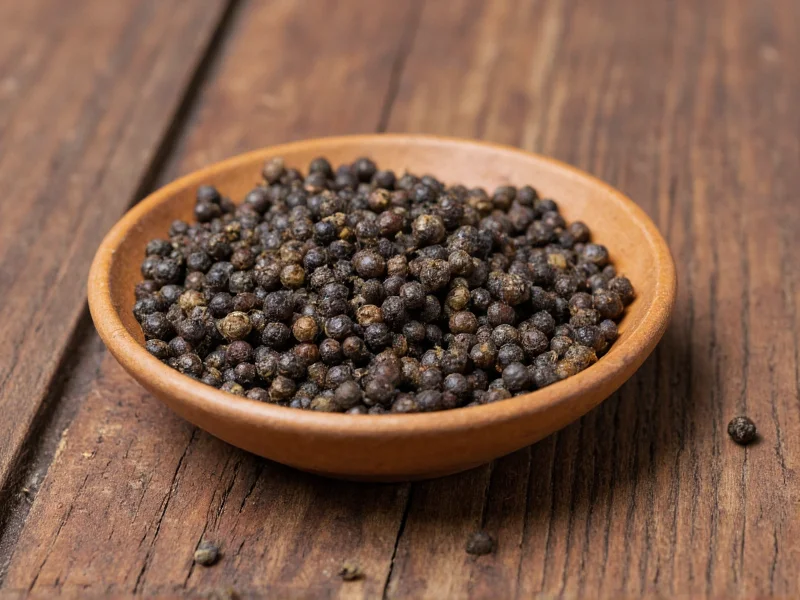Understanding black pepper size matters more than you might think. Whether you're a home cook measuring ingredients, a chef developing recipes, or a food manufacturer standardizing products, precise knowledge of peppercorn dimensions affects flavor extraction, grinding consistency, and recipe accuracy. This guide explores the physical characteristics of black pepper with scientific precision while providing practical culinary applications.
Factors Influencing Black Pepper Size
Several variables determine the final size of black peppercorns:
Botanical Factors
The Piper nigrum vine produces berries that develop into peppercorns. Size varies based on:
- Cultivar differences - Malabar, Tellicherry, and Lampong varieties show distinct size profiles
- Ripeness at harvest - Fully mature berries yield larger peppercorns
- Growing conditions - Soil quality, rainfall, and elevation impact final size
Processing Methods
Post-harvest treatment significantly affects final dimensions:
- Drying technique - Sun-dried peppercorns shrink more than machine-dried
- Sorting process - Commercial producers grade by size (Tellicherry being largest)
- Storage conditions - Humidity exposure can cause slight expansion
| Pepper Type | Average Diameter | Weight per 100 Grains | Common Use Cases |
|---|---|---|---|
| Tellicherry Extra Bold | 5.0-5.5 mm | 18-20g | Gourmet cooking, specialty blends |
| Malabar Special | 4.5-5.0 mm | 16-18g | Everyday cooking, commercial grinding |
| Lampong (Indonesian) | 4.0-4.5 mm | 14-16g | Industrial food production |
| White Pepper | 3.5-4.0 mm | 12-14g | Light-colored sauces, specific cuisines |
Practical Measurement Considerations
Knowing black peppercorn size translates directly to kitchen applications. The physical dimensions determine how many peppercorns equal standard measurements:
Volume-to-Count Conversions
Due to their spherical shape and consistent size, black peppercorns follow predictable volume relationships:
- 1 teaspoon = approximately 12-15 whole peppercorns
- 1 tablespoon = roughly 35-45 whole peppercorns
- 1 ounce (28g) = about 180-200 peppercorns
Grinding Implications
The size of black peppercorns directly affects grinding results:
- Larger peppercorns (5mm+) produce more consistent coarse grinds
- Smaller peppercorns (4mm) grind finer with less waste
- Uniform size ensures even flavor release during cooking
Black Pepper Size in Culinary Context
Professional chefs consider peppercorn dimensions when developing recipes. The surface-area-to-volume ratio changes with size, affecting how quickly flavors infuse into dishes. Larger peppercorns release flavor more gradually, making them ideal for slow-cooked dishes, while smaller grains work better for quick preparations.
When following recipes specifying "whole black pepper," understanding the expected size prevents flavor imbalances. A recipe developed with Tellicherry peppercorns (5mm) will taste noticeably different if made with smaller Lampong variety (4mm) using the same count measurement.
Measuring Black Pepper Without Specialized Tools
Home cooks can estimate peppercorn size using common kitchen items:
- Compare to pencil eraser (about 5mm diameter)
- Use standard measuring spoons as reference
- Stack 10 peppercorns - they should measure approximately 45mm
For precise culinary applications, consider investing in a digital caliper. These affordable tools measure peppercorn diameter to 0.1mm accuracy, ensuring recipe consistency especially important for food bloggers and recipe developers concerned with black pepper measurement equivalents.
Storage Impact on Black Pepper Dimensions
Proper storage maintains peppercorn size and quality. Exposure to humidity causes peppercorns to absorb moisture and expand slightly (up to 0.3mm), while excessive dryness makes them shrink. For consistent measurements, store peppercorns in airtight containers away from heat and light. This preserves both their physical dimensions and volatile oil content responsible for flavor and aroma.
How many millimeters is a standard black peppercorn?
Most mature black peppercorns measure between 4-5 millimeters in diameter, with the industry standard falling around 4.5mm. Premium varieties like Tellicherry Extra Bold can reach 5.5mm, while smaller commercial grades may be as small as 4mm.
Does black pepper size affect flavor intensity?
Yes, size correlates with flavor development. Larger peppercorns typically come from fully mature berries with higher concentrations of piperine (the compound responsible for pepper's heat). However, smaller peppercorns may have slightly more surface area relative to volume, potentially releasing flavor more quickly when ground.
How does black pepper size compare to other pepper varieties?
Black peppercorns are generally larger than white pepper (3.5-4.0mm) because white pepper consists of just the seed with the outer layer removed. Green peppercorns, harvested earlier, are slightly larger (5-6mm) but much softer. All true pepper varieties come from the same Piper nigrum plant, with size differences resulting from harvest timing and processing.
Why do some black peppercorns appear larger than others?
Size variation occurs due to multiple factors: different pepper varieties (Tellicherry vs. Malabar), growing conditions, ripeness at harvest, and processing methods. Commercial grading separates peppercorns by size, with Tellicherry Extra Bold being the largest grade (5mm+), followed by Tellicherry Special (4.5-5mm), and Malabar Special (4-4.5mm).
How does peppercorn size affect grinding in pepper mills?
Larger peppercorns (5mm+) work best in high-quality mills with adjustable mechanisms, producing more consistent grinds. Smaller peppercorns (4mm) may pass through some mills without proper grinding. Uniform size ensures even pressure distribution during grinding, preventing fine powder mixed with large chunks. For consistent results, use peppercorns of similar size and avoid mixing different grades in the same mill.











 浙公网安备
33010002000092号
浙公网安备
33010002000092号 浙B2-20120091-4
浙B2-20120091-4